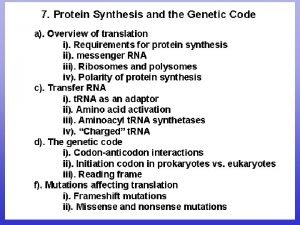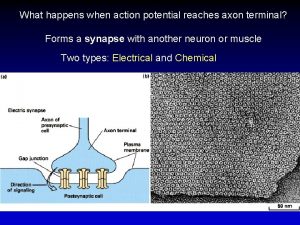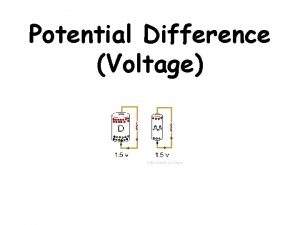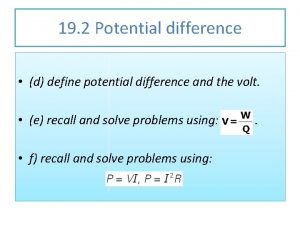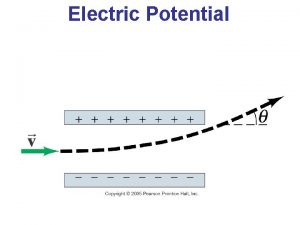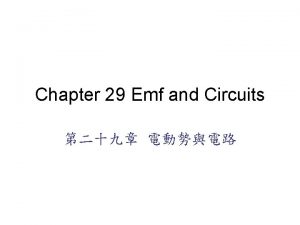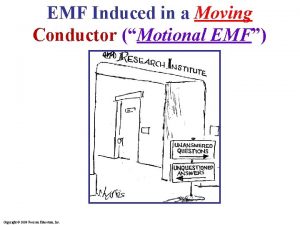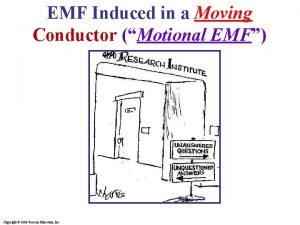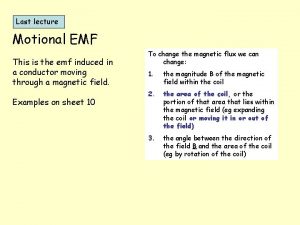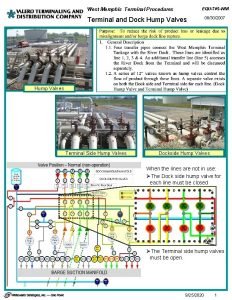EMF and Terminal Potential Difference The emf E


























- Slides: 26

EMF and Terminal Potential Difference The emf E is the open-circuit potential difference. The terminal voltage VT for closed circuit is reduced due to internal resistance r inside source. Open Circuit E = 1. 5 V Closed Circuit VT = 1. 45 V r Applying Ohm’s law to battery r, gives: VT = E - Ir

Finding Current in Simple Circuit Ohm’s law: Current I is the ratio of emf E to total resistance R + r. Cross multiplying gives: IR + Ir = E; VT = IR VT = E - Ir VT = IR VT r R I E + r Battery -

Example 2. A 3 -V battery has an internal resistance of 0. 5 W and is connected to a load resistance of 4 W. What current is delivered and what is the terminal potential difference VT? R r I = 0. 667 A VT = E – Ir VT = 3 V – (0. 667 A)(0. 5 W) VT = 2. 67 V R=4 W I E=3 V + r = 0. 5 W -

Power in Circuits Recall that the definition of power is work or energy per unit of time. The following apply: The first of these is normally associated with the power gains and losses through emf’s; the latter two are more often associated with external loads.

Power, Potential, and EMF Consider simple circuit: Terminal Voltage VT Multiply each term by I: V T I = E I - I 2 r r E VT = E - Ir + I Battery - R The power delivered to the external circuit is equal to the power developed in the emf less the power lost through internal resistance.

Example 3. The 3 -V battery in Ex. 2 had an internal resistance of 0. 5 W and a load resistance of 4 W. Discuss the power used in the circuit. From Ex. 2, we found: I = 0. 667 A R r VT = 2. 67 V Power developed in emf: R=4 W I E=3 V EI = (3. 0 V)(0. 667 A) = 2. 0 W Power lost in internal r: I 2 r = (0. 667 A)2(0. 5 W) = 0. 222 W + r = 0. 5 W -

Example 3 (Cont. ). Discuss the power used in the simple circuit below. Power in emf: EI = 2. 00 W Power loss: I 2 r = 0. 222 W Power lost in external load R: I 2 R = (0. 667)2(4 W) = 1. 78 W This power can also be found using VT = 2. 67 V R r R=4 W I E=3 V + r = 0. 5 W - Actual power VTI = (2. 67)(0. 667 A) = 1. 78 W used externally.

Example 3 (Cont. ). Discuss the power used in the simple circuit below. Power in emf: EI = 2. 00 W Power loss in internal r: R r I 2 r = 0. 222 W R=4 W I E=3 V Power lost in external load R: I 2 R = VTI = 1. 78 W V T I = E I - I 2 r + r = 0. 5 W - 1. 78 W = 2. 00 W – 0. 222 W

A Discharging EMF When a battery is discharging, there is a GAIN in energy E as chemical energy is converted to electrical energy. At the same time, energy is LOST through internal resistance Ir. A 12 V, 1 W + E r - B I=2 A Discharging: VBA = E - Ir GAIN LOSS 12 V - (2 A)(1 W) = 12 V - 2 V = 10 V If VB= 20 V, then VA = 30 V; Net Gain = 10 V

Charging: Reversing Flow Through EMF When a battery is charged (current against normal output), energy is lost through chemical changes E and also through internal resistance Ir. A 12 V, 1 W + E r - I=2 A Charging: VAB = E + Ir LOSS -12 V - (2 A)(1 W) = -12 V - 2 V = -14 V If VA= 20 V, then VB = 6. 0 V; Net Loss = 14 V B

Power Gain for Discharging EMF Recall that electric power is either VI or I 2 R When a battery is discharging, there is a GAIN in power EI as chemical energy is converted to electrical energy. At the same time, power is LOST through internal resistance I 2 r. A 12 V, 1 W + E r - B I=2 A Discharging Net Power Gain: VBAI = E I- I 2 r (12 V)(2 A) - (2 A)2(1 W) = 24 W - 4 W = 20 W

Power Lost on Charging a Battery Recall that electric power is either VI or I 2 R When a battery is charged (current against normal output), power is lost through chemical changes EI and through internal resistance Ir 2. A 12 V, 1 W + E r - B I=2 A Charging Net Power Lost= EI + I 2 r (12 V)(2 A) + (2 A)2(1 W) = 24 W + 4 W = 24 W

Example 4: A 24 -V generator is used to charge a 12 -V battery. For the generator, r 1 = 0. 4 W and for the battery r 2 = 0. 6 W. The load resistance is 5 W. 12 V. 6 W First find current I: + E 2 r 2 I R 5 W Circuit current: I = 2. 00 A What is the terminal voltage VG across the generator? VT = E – Ir = 24 V – (2 A)(0. 4 W) 24 V. 4 W + E 1 r 1 - I VG = 23. 2 V

Example 4: Find the terminal voltage VB across the battery. Circuit current: I = 2. 00 A 12 V + E 2 VB = E + Ir = 12 V + (2 A)(0. 4 W) Terminal VB = 13. 6 V Note: The terminal voltage across a device in which the current is reversed is greater than its emf. . 6 W r 2 - I R 5 W 24 V. 4 W + E 1 r 1 - I For a discharging device, the terminal voltage is less than the emf because of internal resistance.

Ammeters and Voltmeters A + V Voltmeter Emf Rheostat - Source of EMF Ammeter Rheostat

The Ammeter An ammeter is an instrument used to measure currents. It is always connected in series and its resistance must be small (negligible change in I). A + E - rg Digital readout indicates current in A Ammeter has Internal rg The ammeter draws just enough current Ig to operate the meter; Vg = Ig rg

Galvanometer: A Simple Ammeter The galvanometer uses torque created by small currents as a means to indicate electric current. A current Ig causes the needle to deflect left or right. Its resistance is Rg. 20 N 10 0 10 20 S The sensitivity is determined by the current required for deflection. (Units are in Amps/div. ) Examples: 5 A/div; 4 m. A/div.

Example 5. If 0. 05 A causes full-scale deflection for the galvanometer below, what is its sensitivity? 20 Assume Rg = 0. 6 W and that a current causes the pointer to move to “ 10. ” What is the voltage drop across the galvanometer? N 10 0 10 20 S Vg = (25 m. A)(0. 6 W) Vg = 15 m. V

Operation of an Ammeter The galvanometer is often the working element of both ammeters and voltmeters. A shunt resistance in parallel with the galvanometer allows most of the current I to bypass the meter. The whole device must be connected in series with the main circuit. Ig I Rg Rs Is I = Is + Ig The current Ig is negligible and only enough to operate the galvanometer. [ Is >> Ig ]

Shunt Resistance Ig Current Ig causes full-scale deflection of ammeter of resistance Rg. What Rs is needed to read current I + from battery VB? VB Junction rule at A: - Ammeter Rg Is A Rs R I = 10 A I = I g + Is Or Is = I - I g Voltage rule for Ammeter: 0 = I g R g – I s. R s; I s. R s = I g R g (I – Ig)Rs = Ig. Rg

Example 6. An ammeter Ammeter has an internal resistance Ig of 5 W and gives full- scale rg defection for 1 m. A. To 1 m. A read 10 A full scale, what shunt resistance Rs is A rg + needed? (see figure) VB - 5 W R I = 10 A Rs = 5. 0005 x 10 -4 W The shunt draws 99. 999% of the external current.

Operation of an Voltmeter The voltmeter must be connected in parallel and must have high resistance so as not to disturb the main circuit. A multiplier resistance Rm is added in series with the galvanometer so that very I little current is drawn from the main circuit. The voltage rule gives: Ig Rg Rm VB V B = I g. Rg + I g. Rm

Multiplier Resistance Voltmeter Current Ig causes full-scale deflection of meter whose resistance is Rg. What Rm is needed to read voltage VB of the battery? V B = I g. Rg + I g. Rm Ig R m = V B - I g Rg VB I Rm R Which simplifies to:

Example 7. A voltmeter Voltmeter has an internal resistance 5 W Ig of 5 W and gives full- scale Rg deflection for 1 m. A. To Rm 1 m. A read 50 V full scale, what multiplier resistance Rm is needed? (see figure) VB I R Rm = 49995 W The high resistance draws negligible current in meter.

Summary of Formulas: Discharging: VT = E - Ir Power: VTI = EI - I 2 r + r E I - Charging + r E I - Discharging Charging: VT = E + Ir Power: VTI = EI + I 2 r

Summary (Continued) Ammeter Voltmeter Ig Rg + Rm A Rs VB - Rg R I VB I R
 Difference between potential difference and emf
Difference between potential difference and emf Equipotential lines
Equipotential lines Electrostatic potential difference
Electrostatic potential difference Difference between sales potential and market potential
Difference between sales potential and market potential Electric potential
Electric potential Potential energy due to point charges
Potential energy due to point charges What is electric potential
What is electric potential Terminal and non terminal in compiler design
Terminal and non terminal in compiler design Prokariotik dan eukariotik
Prokariotik dan eukariotik Axon terminus
Axon terminus Graded potentials
Graded potentials Osmotic potential
Osmotic potential V=pe/q
V=pe/q Horrocks apparatus
Horrocks apparatus Why is water potential measured in pascals
Why is water potential measured in pascals Water potential definition
Water potential definition Graded potential vs action potential
Graded potential vs action potential Action potential
Action potential Graded potential vs action potential
Graded potential vs action potential Difference between action and graded potential
Difference between action and graded potential Water potential
Water potential Sources of bioelectric potentials
Sources of bioelectric potentials Hypopolarization
Hypopolarization End plate potential
End plate potential Action potential resting potential
Action potential resting potential Action potential resting potential
Action potential resting potential Electrostatic potential energy definition
Electrostatic potential energy definition








